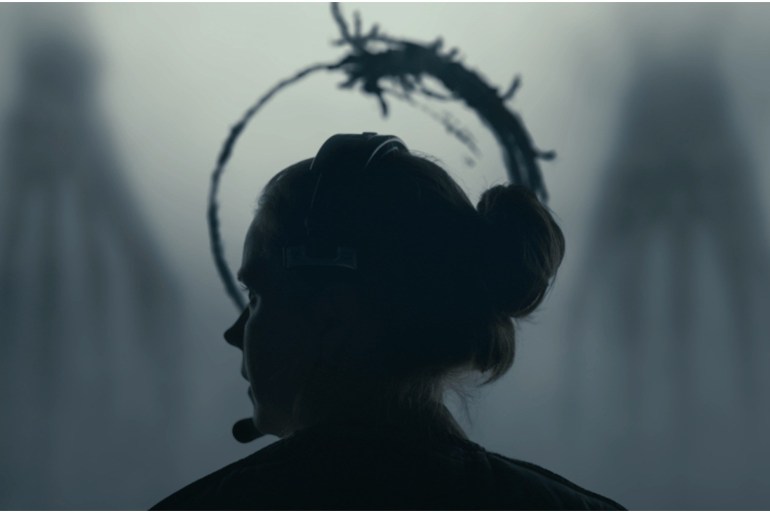Film Frame Friday is a regular series where one of our contributors will pick a film and highlight its unique cinematic style, from cinematography to mise-en-scene, and editing. It is a great way to not only introduce someone to a new film but to bring new conversations to the table. Click here for more entries in the series.
In my latest spotlight article, I praised Denis Villeneuve’s Arrival as a triumph of contemplative Sci-Fi. It has been nearly two years since I staggered out from a screening of Arrival, and till this day I still marvel at its power and beauty. How gracefully the film weaved together profound messages with a cerebral—and almost impossible to adapt—story! It is a film that I frequently revisit, and in this particular revisit to one of the best Sci-Fi films of all time, we shall focus on Arrival’s visual storytelling.
Arrival has a non-linear story, but the film does not reveal its hand all at once. To camouflage the achronologically arranged scenes, Arrival makes extensive use of Kuleshov Effect—an editing effect named after Soviet director and film theorist, Lev Kuleshov. In Kuleshov’s experiment, he edited together a portrait shot of an actor with neutral expression with images of a plate of soup, a young girl in a coffin, and a woman lying on a couch; the different combinations result in the audience projecting different emotions (hunger, sadness, and lust) onto the actor. In short, filmmakers can convey new messages or evoke emotions through the assembly of scenes alone.
Much of Arrival’s ingenious disguise was achieved this way; we see Louise’s (Amy Adams) daughter pass away from to an incurable disease, and next time we see her, we automatically assume she is grieving. Additionally, as Louise’s proficiency in Heptapod B (the written language of the heptapods) grows, visions of her daughter start to come to her in intervals. These scenes resemble memories because the editing mimics the act of recalling, and we interpret the shock and confusion on Louise’s face as the pain of loss thanks to the heartbreaking montage at the beginning of the film.
Of course, having finished watching the film, we know that Louise does not give birth to her daughter until after the alien visitors—the heptapods—have departed Earth. Nor were Louise’s memories of Hannah simple flashbacks triggered by her surroundings. The editing of Arrival did most of the heavy-lifting on hiding the film’s unorthodox chronology—allowing storytelling conventions and the audience’s expectation to fool the beholders themselves—but the cinematography played a hand in it as well.
Visually speaking, Arrival isn’t an immediately striking film. If you are looking for a movie that makes people gasp in their seats with vibrant colors and breathtaking compositions, then you must continue on with your search. This is not a criticism leveled at the director of photography Bradford Young’s skills, quite the opposite, the subtle beauty of Arrival is, in fact, a testament to Young’s talent. Not only does the cinematography of Arrival stylistically feels like an extension of Louise’s character and of the film’s quiet essence, but it is also deeply integral to the storytelling process.
“Louise is bereft of her daughter. She is alone.” This is an idea that the film must intermittently reaffirm in order hide Heptapod B’s future-peering effect. To do that, the cinematography employs several methods, and the most apparent one is the color grading.
Blue is the color traditionally associated with melancholy, and it has a dominant presence throughout most of Arrival’s runtime; nighttime and indoor scenes can be entirely comprised of blue and black. The rest of the color spectrum are present in this movie, but they often appear muted, giving the film a cold and depressed look. Arrival is perhaps one of the few movies that do not benefit from High Dynamic Range technology—a type of format used in 4K UHD Blu-rays, streaming services and select theaters to produce brighter white, darker black, and a wider color gamut, but 4K versions of this film do not differ significantly from the regular Blu-ray in these sequences. The scene where Louise first witnesses a Heptapod ship in its full glory features large swaths of greenery, blue sky, and flowing cloud, but it is no less gloomy and drab than the rest of Arrival.
Humankind’s first contact with the heptapods is only one half of the story. The other half that directly contrasts the solemn, procedural nature of an interstellar diplomatic mission amidst great tension, is Hannah. Heptapod B is a tool that allows Louise to redefine the meaning of her life, and Hannah is the manifestation of a lesson learned—a lesson of love and life (no matter how brief!), and the colors reflect what she represents. Although the scenes with Hannah are still in keeping with the film’s firm rule against vibrant colors, they are a departure from the cold and austere look of Louise’s previous life; the sunlight and a warmer tone form gentle and welcoming images.
The color palette is not the only thing that set the flash-forwards apart from the rest of the film. The handheld camera movement in flash-forward scenes—reminiscent of homemade videos—imbues them with intimacy, while the pre-contact Arrival uses dolly and Steadicam to present a more deliberate and sterile impression.
The camera also reinforces Louise’s loneliness in other ways. The film periodically centers the frame on the back of Amy Adams’s head—it is not quite the same as PoV shots, because in those shots, Louise in the foreground is the only object in focus, and the bokeh isolates Louise from her surroundings. These sequences draw attention to Louise’s silent presence while purposely denying the viewer her reactions. The camera angle simultaneously communicates a sense of alienation and invites us to project that feeling back to her.
Arrival forgoes the Sci-Fi sheen of its peers, instead, it adopts the plainness of real life by incorporating objects from everyday life— the unadorned GMC pickup trucks, the whining scissor lift, a canary in a cage. The juxtaposition of the mundane and the utterly alien heptapods reminds us that the tide of life is equally capable of bringing the unexpected and the extraordinary, and the film inspires us to live our lives to the very best. Arrival is a masterclass in cinematic storytelling, and its visuals are proofs of its power.
To help us continue to create content, please consider supporting us on Patreon.


